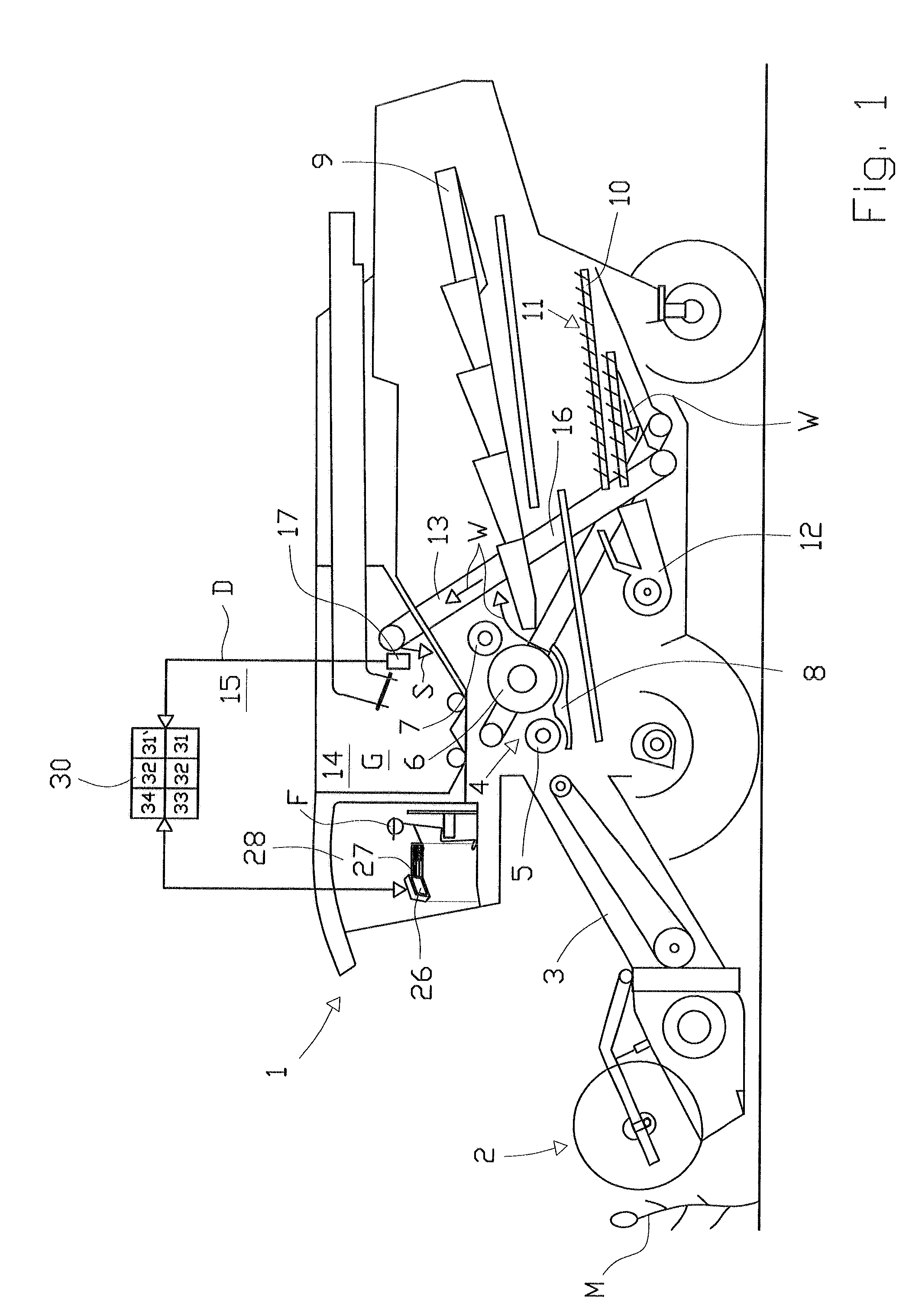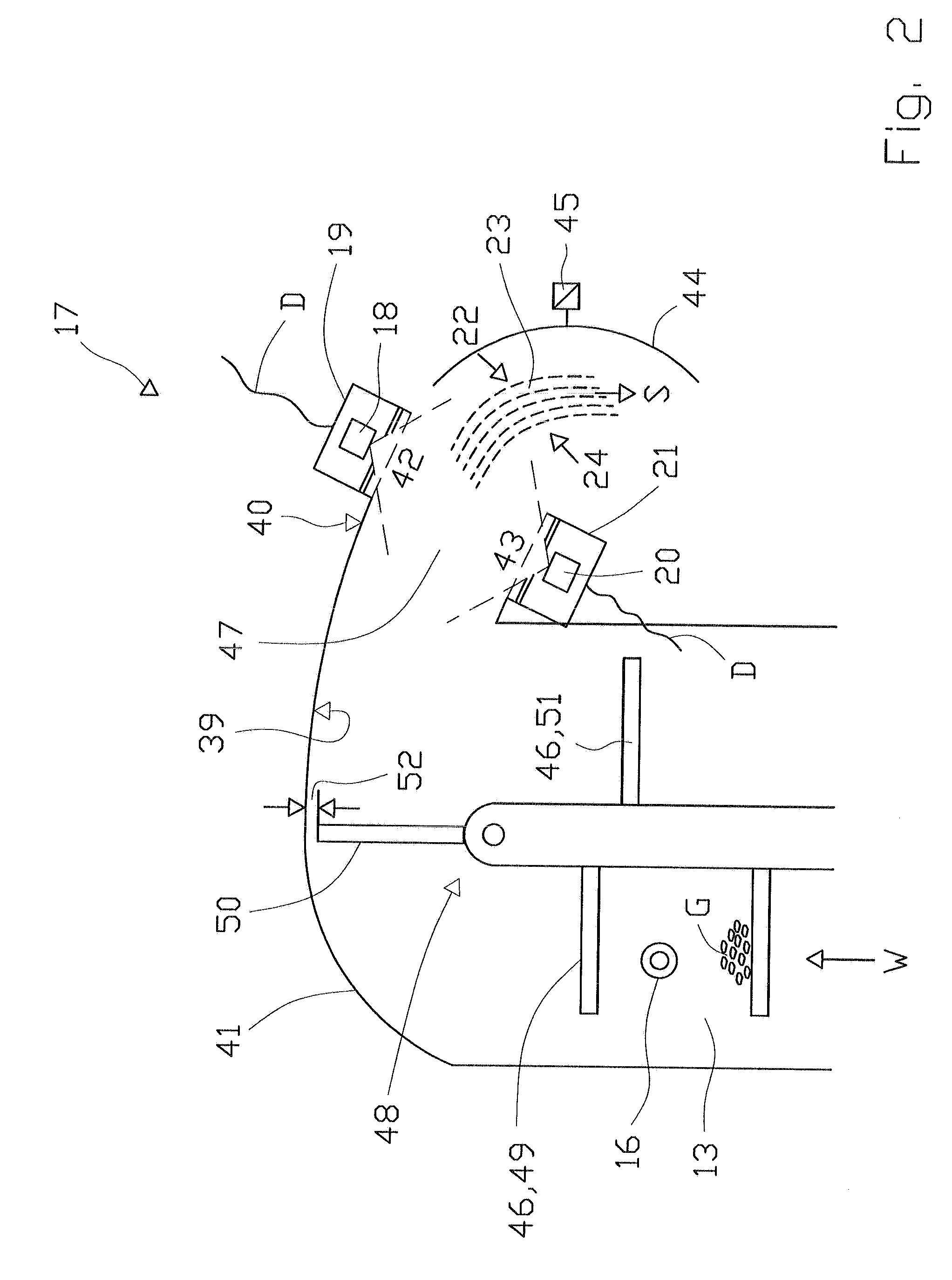Device for detection and determination of the composition of bulk material
a bulk material and composition technology, applied in the field of agricultural and harvesting crop processing, can solve the problems of grain loss, interference with the further processing, and large portion of damaged grain, and achieve the effect of improving the detection of crop material flow
- Summary
- Abstract
- Description
- Claims
- Application Information
AI Technical Summary
Benefits of technology
Problems solved by technology
Method used
Image
Examples
first embodiment
[0034]As shown in FIG. 1, control unit 30 is connected via a data line D to image recording unit 17 according to the invention. Image recording unit 17 can have various technical embodiments. It can comprise two to four stationary image detectors 18, 20 or one or more movably disposed image detectors 18, 20. The principle is to use imaging detectors to detect, with the aid of an optical recording, the separation of crop material flow S in a grain elevator 13 before transfer thereof into a container 14 in order to determine crop material quality. The detection and evaluation method is the same in all three technical embodiments of device 15. Of the three technical embodiments of image recording units 17, an image recording unit 17 comprising two stationary image detectors 18, 20 is depicted preferably in FIG. 2. Image detectors 18, 20 are diametrically opposed at the outlet of an elevator head 41, i.e. discharge point 40, and are therefore separated by 180 degrees. Image detectors 18...
second embodiment
[0035]In a development (not depicted in FIG. 2) of optimal image recording unit 17, one more image detector is located on both sides of discharge point 40. Using the total of four image detectors 18, 20, it is now possible to detect crop material flow S from all sides, each image detector 18, 20 being disposed approximately perpendicularly to surface 23 of crop material flow S. This technical embodiment of an image recording unit 17 corresponds to the second embodiment described above.
[0036]The opening of the angular field of each image detector 18, 20 forms a field of view 42, 43. A yield sensor in the form of a baffle plate 44 and a weight sensor 45 assigned thereto is located within said field of view 42, 43, at outlet 40 of elevator head 41, and can function as an alternative to the yield sensor designed as light barrier 16. Image detectors 18, 20 detect the fill level of crop G in the region of elevator head 41, which is evaluated in control unit 30 using image processing. The ...
third embodiment
[0043]In device 15 described above, it is provided according to the invention for at least one and preferably both stationary image detectors 18, 20 to be movable. This embodiment is not depicted in entirety in FIG. 2. To this end, housing part 19, 21 containing image detector 18, 20 is displaceably disposed at discharge point 40. To displace housing part 19, 21, housing part 19, 21 is connected via a connecting means to a drive unit which is not depicted. Discharge point 40 comprises a longitudinal slot through which the image or image series can be recorded.
[0044]It will be understood that each of the elements described above, or two or more together, may also find a useful application in other types of constructions differing from the types described above.
[0045]While the invention has been illustrated and described as embodied in a device for detection and determination of the composition of bulk material, it is not intended to be limited to the details shown, since various modi...
PUM
 Login to View More
Login to View More Abstract
Description
Claims
Application Information
 Login to View More
Login to View More - R&D
- Intellectual Property
- Life Sciences
- Materials
- Tech Scout
- Unparalleled Data Quality
- Higher Quality Content
- 60% Fewer Hallucinations
Browse by: Latest US Patents, China's latest patents, Technical Efficacy Thesaurus, Application Domain, Technology Topic, Popular Technical Reports.
© 2025 PatSnap. All rights reserved.Legal|Privacy policy|Modern Slavery Act Transparency Statement|Sitemap|About US| Contact US: help@patsnap.com



